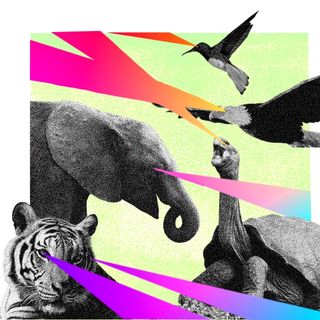
Reef Fishes Thought to Be ‘Ugly’ Are More Endangered Than ‘Pretty’ Ones, Finds Study
“There is a need for us to make sure that our ‘natural’ aesthetic biases do not turn into a bias of conservation efforts,” researchers said.

The mandarin fish is glorious. This small, brightly-colored fish carries stripes and patterns — orange morphing into yellow, and blue holding the green. There’s a hint of splendor in its biological name too, Synchiropus splendidus. Its neighbor, the beautiful bluefish, on the other hand, has blue-green hues running at its back, with touches of silver or white along the sides. Pit the two against each other, and the popular opinion is the bluefish is “drab” and less attractive than the mandarin.
For the first time, researchers from the University of Montpellier in France measured the aesthetic value of 2,416 reef fish — the fish that resides near coral reefs.
Fish thought to be less aesthetically pleasing are more likely to need conservation support. Yet, they are less likely to get it because of our natural aesthetic biases, according to the study, published Tuesday in PLOS Biology. This also means the fish most likely to rank as “ugly” are the most endangered species in the world. “There is a need for us to make sure that our ‘natural’ aesthetic biases do not turn into a bias of conservation effort,” saidNicolas Mouquet a community ecologist at the University of Montpellier, and one of the lead authors of the study.
The fish’s aesthetic value was determined first with the aid of a survey and then with A.I. predictions. The researchers conducted an online survey asking 13,000 people to rate the attractiveness of 481 ray-finned reef fish. This data was then relayed to an A.I. system that predicted people’s chances of liking a bigger sample size: now put to test were 2,417 commonly known reef fish species, their features captured from 4,400 different photos.
Charisma lacks definition, but some features evidently added to what was perceived as beautiful and what wasn’t. The quality and diversity in the color of a fish — and just how saturated the colors were — mattered. A pop of yellow and orange, like our friend Nemo, would clearly be a winner if there were a contest. Then, did it have well-outlined patterns and brilliant texture? “Most of the fish that people find not beautiful are drab fish with an elongated body shape and no clearly delineated color patterns,” said lead study author and ecologist Nicolas Mouquet. The said metrics would instantly mean the likes of steenbras and bocaccio rockfish were deemed less aesthetic.
The weighted factor was the shape of the fish: rounded shapes tended to be rated higher in public opinion. “For instance, high color heterogeneity (quality) and well-delineated patches of contrasted lightness, as observed in angelfish and butterflyfish, makes them pleasant to [people],” Mouquet told DW. The butterflyfish looks like the wings of a butterfly (not that it was fishing for compliments).
Related on The Swaddle:
Divorce Rates in Albatrosses May Be Rising Due to Climate Change: Study
Their less attractive cousins, if you will, are more likely to be evolutionary distinct than others — that is, they are genetically different from other fish and more unique. So while the bright, colorful, and round-bodied fish species – take your queen angelfish and the striped cowfish – were most often called “beautiful,” they had little genetic variations so to speak of. And arguably, the “beautiful” fish is a rarity; the majority of fish biodiversity includes species that would not fit the standards of aestheticism.
Aesthetic value is, arguably, how well any species conform to conventional standards of attractiveness — perhaps those set by social conditioning or those thatpeople are programmed to find prettier. Regardless, some are deemed “more attractive” by no effort on their part, just like some are “less attractive” — or even “ugly,” to put it crudely — for no fault of theirs.
These biases, though, determine which fish species we choose to save. Take the telescope fish (with truly bizarre, tubular eyes). Or, the round herring, with its soft dorsal fin. They are both ecologically distinct, but also ranked as “threatened” on the International Union for Conservation of Nature Red List.
The study aptly contextualizes the appearances of the “less attractive” fish too: these species have adapted to look this way. They are of greater commercial interest and are more likely to be overfished (like the round herring that is often used as fish bait). These water-dwelling species ditch curiosity for preservation and hide within more homogenous habitats like water columns.
Related on The Swaddle:
This presents a paradox of sorts. The more “beautiful” fish are less likely to be endangered, and yet they become the poster species for all conservation efforts. “Species such as clownfish and colorful parrotfishes are definitely the easiest for people to connect with … and it makes sense why they are often used as the figurehead of conservation efforts,” said Chloe Nash, a researcher of the biogeography of marine fish at the University of Chicago, who was not involved in the study.
Moquet then points to the evident, but “important mismatches between potential public support for conservation and the species most in need of this support.” This rift between a fish’s perceived aesthetic value and its likelihood of becoming extinct only stands to widen.
The aesthetic bias is not limited to fish species; some research has found that aesthetics are the reason mammals, fish, and reptiles (vertebrates) get more time in the conservation sun in comparison to insects, spiders, and worms (invertebrates). How much more? Vertebrates enjoy six times the investment in conservation efforts than the latter, according to a study from 2020. The research too reiterated this bias built on a popularity gap; animal species’ popularity (and aesthetics mattered here, along with other ways to measure charisma) was a deciding factor in how conservation efforts were decided.
Just how much aesthetic value would determine scientific and policy decisions is still a question deserving of deeper scrutiny. The aesthetic experience is pivotal and potent in dictating how the ecosystem is informed, but there are other quantifiable variables too, noted Joan Iverson Nassauer, a scholar of landscape ecology at the University of Michigan, who was not involved in the study.
Yet, we know the conservation effort is imperfect; it is more likely to favor some species more than others, and those not featuring in figureheads or not deemed attractive inevitably become sidelined.
At least it helps to know that if beauty meant uniqueness, the steenbras would be beautiful too.
Saumya Kalia is an Associate Editor at The Swaddle. Her journalism and writing explore issues of social justice, digital sub-cultures, media ecosystem, literature, and memory as they cut across socio-cultural periods. You can reach her at @Saumya_Kalia.
Related


When Money Can — and Can’t — Buy Happiness, According to Research
